Invisible Leaks | Long-term Continuous Monitoring of Zambezi River Demonstrates Massive Swings in Carbon Releases
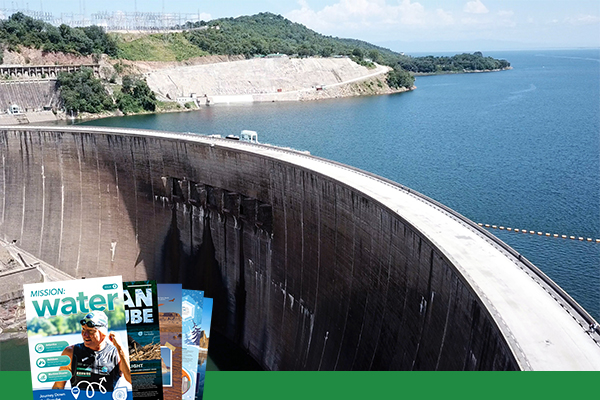
Kariba Dam, Zambia
Kariba Dam is a staggering sight. At 579 meters wide, it spans the Zambezi River, one of Africa's largest waterways. At 128 meters tall and 24 meters thick, the sweeping concrete wall holds back the world's largest reservoir. Its turbines generate 1,830 megawatts (MW) of electricity, shunted to both Zambia on one side of the river and Zimbabwe on the other.
Despite the eye-popping impact of the dam, some of the most interesting discoveries around it are invisible. A research team from the Swiss Federal Institute of Technology, ETH Zurich, led by Elisa Calamita and principal investigator Bernhard Wehrli, calculated that the "clean" hydropower project releases 18,000 to 35,000 metric tons of carbon as carbon dioxide per year. (According to a greenhouse gas calculator developed by the U.S. Environmental Protection Agency, that is equivalent to the carbon emissions from burning 36,500 to 73,000 short tons of coal.)
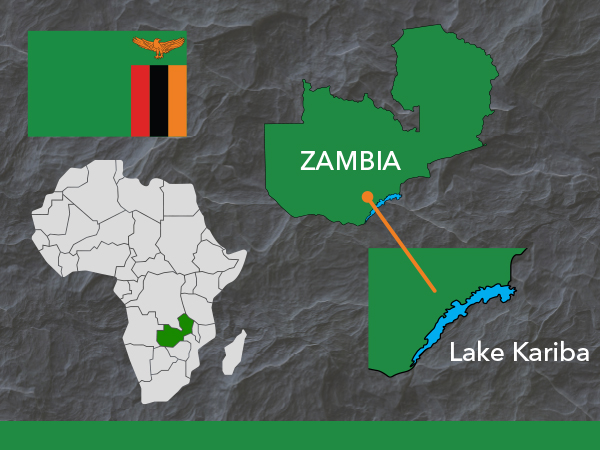
Located along Zambia's border with Zimbabwe, Lake Kariba is the largest artificial lake in the world by volume.
What is more striking is that through a year-long, continuous monitoring study of the Lake Kariba reservoir behind the dam and the Zambezi just downstream of it, the ETH Zurich team charted huge seasonal and even daily swings in carbon dioxide emissions. Calculations based on those spot data could lead to estimates that could potentially overestimate carbon emissions by up to 30% or underestimate them by as much as 90%!
"It's widely recognized that there are emissions from lakes and reservoirs, and that there can be downstream emissions from hydropower projects," notes Scott Winton, a research scientist at Stanford University in Palo Alto, California, who was an ETH post-doc researcher working with Calamita. "It's quite a challenge to capture all the seasonal dynamics to estimate those emissions accurately."
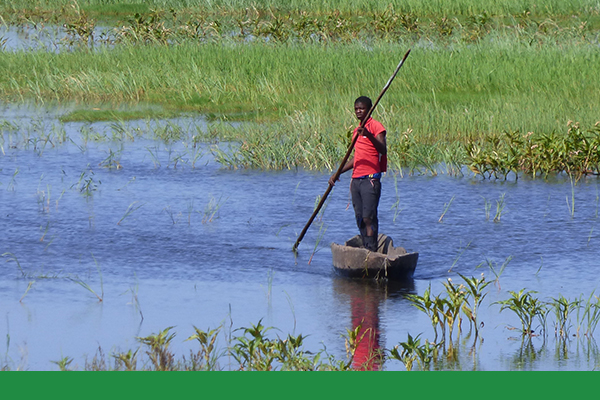
Fishing is a common activity for those living along the Zambezi River.
Organic Matter
Winton explains that organic matter decomposes when it falls to the bottom of deep lakes and reservoirs, releasing carbon dioxide (and, in anoxic conditions, methane). Some of the carbon dioxide (CO2) floats to the lakes' surface and is released into the atmosphere. Much remains dissolved in the water, especially in cold layers of the water profile. Seasonal temperature dynamics cause the stratified water of reservoirs to mix, which can lead to large, brief emissions of long-dissolved CO2 to the air. Similarly, when turbine intakes draw water from deep in a reservoir, the flow can be cold and heavily loaded with dissolved CO2, or it can be relatively mixed and low on carbon dioxide.
The challenge for most researchers is that they can only take a few measurements and must extrapolate emissions from them.
"If you're reliant on a manual process—and with gas flux measurements, that's what we're stuck with—you're prone to missing those fluctuations," Winton notes. "What's so important about long-term, automated data gathering is it can help you capture seasonal discrepancies and even daily cycles related to operations, which we saw at Lake Kariba."
The team warned of the potential for large inaccuracies in carbon release estimates from hydropower facilities in the Proceedings of the National Academy of Sciences. The paper highlights an urgent need for more accurate appraisals—there are more than 58,000 dams five meters or higher around the world and nearly 3,700 hydropower dams currently under construction or in the planning process.
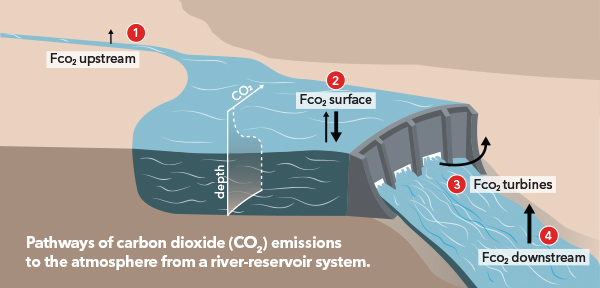
- Minimal CO2 is released from streams/rivers that lead to the reservoir.
- In the reservoir, organic matter sinks and is broken down by microbes. This process consumes oxygen and produces CO2.
- Water used to turn the dam’s turbines often comes from the lower, CO2-rich portion of the reservoir’s water column. This results in a significant amount of CO2 degassing at the turbines.
- The remaining excess CO2 is released downstream from the dam.
Graphic adapted from Calamita et al. 2021
Carbopeaking
Demand for electricity peaks in the morning and late afternoon among customers of the Kariba Dam's electricity. There's a term for periodic spikes in water flow that result from water releases: hydropeaking. As CO2 emissions fluctuate in phase with the water releases, the ETH Zurich team coined a term to describe their rhythms: carbopeaking.
Carbopeaking is the result of two factors—an increased volume of CO2 in the larger quantities of water released through the dam, and the higher surface area of the swollen river, which permits greater release of carbon dioxide into the air.
The team observed strong evidence of carbopeaking in a year-long data set collected three kilometers downstream of the dam and 75 kilometers downstream, then compared to measurements from a reference site roughly 480 kilometers upstream near Victoria Falls. The CO2 emissions rate of the released reservoir water could double in just an hour, and over the year, it fluctuated
from 24 to 3,730 C m2/d-1.
It's easy to see how extrapolating emissions figures from manually gathered data could lead to wild over- or under-estimation.
The Chisamu War
Kariba Dam has been in the spotlight before. During its construction, which began in 1955, it was celebrated for its size and the electricity it would bring to Zambia and Zimbabwe. The project would also displace 57,000 Tonga inhabitants of the Gwembe Valley, which became Lake Kariba.
In 1958, Tonga warriors faced off with constables of Northern Rhodesia (which is now Zambia), a protest against the forced move covered by news media around the world. The standoff turned into a shooting, and eight Tonga fighters were killed in what became called the Chisamu War.
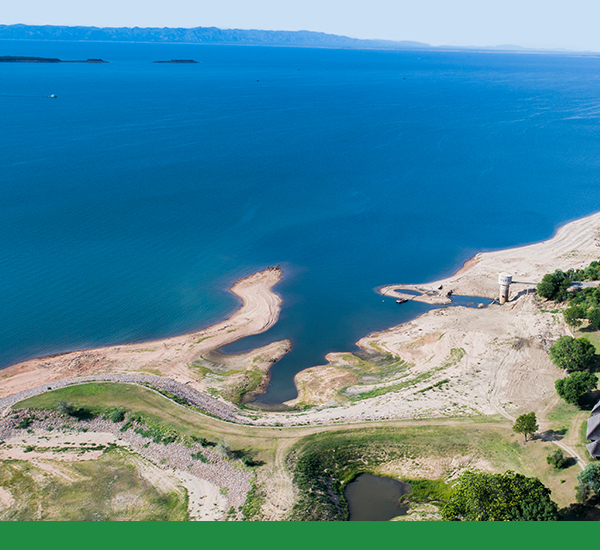
Gwembe Valley was flooded upon the completion of the Kariba Dam, displacing 57,000 Tonga inhabitants.
Key Tool: High-Frequency Data with EXO2 Sondes
Winton says the key tool for recognizing and quantifying the carbopeaking events was the team's suite of YSI EXO2 Multiparameter Sondes. Every hour for nearly a year, each sonde measured temperature, conductivity, pH, and dissolved oxygen.
"We couldn't have done this study without that high-frequency information," Winton notes. "Having a sensor that's able to sit there and measure for you hourly for a really long time allows you to answer a whole bunch of questions that you couldn't otherwise. And, especially if you're interested in hydropower, a lot of those questions are happening at a really high frequency, hour to hour. Without those automated sensors, we couldn't create the term 'carbopeaking,' and we couldn't tell this story."
Winton was already very familiar with YSI sondes from his doctoral research at Duke University.
"When I first went into the field with my Ph.D. supervisor, he said, 'always bring a YSI because it's so useful to get all these parameters instantly,'" Winton recalls. "He was doing all this biogeochemistry work, and you have to work really hard to get samples and analyze them in the lab to get data. But with the sonde you can get a lot of information for free, essentially."
In addition to direct measurements from their sonde in Zambia, Winton points out that he and his colleagues were able to compute carbon dioxide levels from the pH and conductivity values in the EXO2 data sets.
"There's a balance between CO2 and bicarbonate, carbonic acid in water depending on the pH, and these other forms of inorganic carbon change the conductivity. So if you have pH and conductivity, you can back-calculate the CO2 component," he explains. "With this high-frequency data set, we could put together the CO2 concentration and figure out that there were a lot of carbon emissions from the dam—leaking carbon."
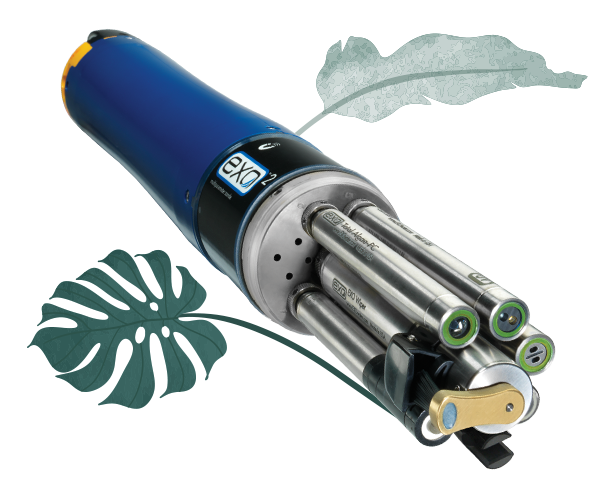
Continuous water quality monitoring with the YSI EXO2 allowed the team to characterize carbopeaking events.
The research team also measured a significant amount of methane, a more potent but shorter-lived greenhouse gas, bubbling up from the oxygen-starved lake bottom.
"Especially in tropical dams, this is common because there's often a lot of organic matter," Winton says. "Even if you don't have totally anoxic bottom water, the sediments themselves are going to become anoxic if you have a lot of organic matter accumulating. If you have decomposition in an anoxic environment, you're going to end up producing a lot of methane. As it gets more and more concentrated, it's going to diffuse up into the water and also going to potentially form bubbles, and those bubbles are going to come up and result in emission into the atmosphere."
ETH Zurich scientists measured carbon dioxide levels at 17 locations in the Zambezi, its tributaries, and in Lake Kariba. They also captured water samples to analyze back at the lab in Switzerland for carbon dioxide and methane. Finally, they used YSI handheld instruments to measure temperature, dissolved oxygen, conductivity, and pH to explore the influence of tributaries, measure conditions in the hypolimnion deep in the lake, and cross-validate the EXO2 data.
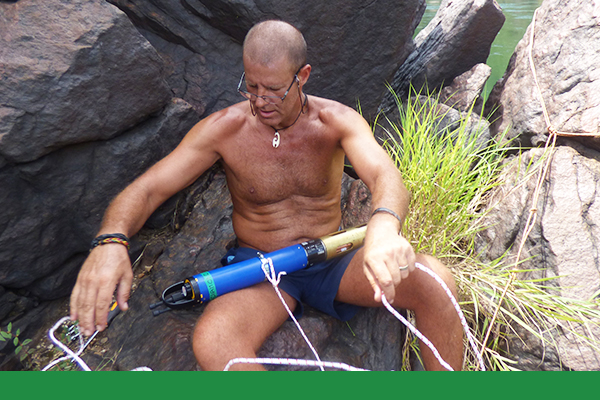
Cristian Teodoru, a member of the field team, prepares the EXO2 for deployment below the Kariba Dam.
Every three months, the researchers retrieved each EXO2, checked its condition, downloaded data, replaced its batteries, and calibrated the sensors.
"We wanted to come back anyway to do manual measurements across different phases of the hydrologic cycle, so it fit our sampling plan," Winton notes.

Finding a snapped sonde cable raised the strong likelihood that the team's field site was visited by a hippopotamus, the deadliest mammal in Africa. (Yes, hippos kill more people in Africa than lions do.) That's just another day at work along the Zambezi River, which forms the border between Zambia and Zimbabwe.
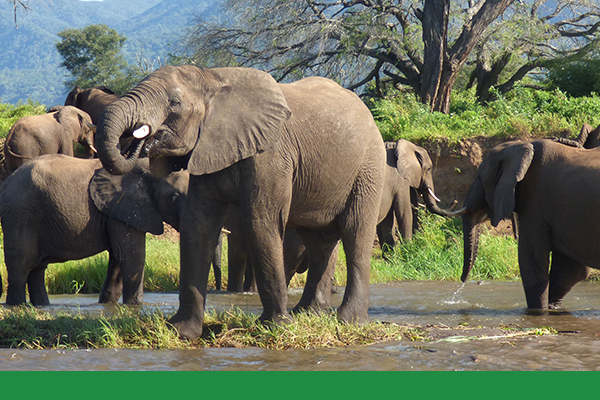
The research team often saw elephants crossing the Zambezi River during their visits into the field.
Safety is always a concern when gathering measurements and samples in the water. But the concern meter ratchets up significantly when sampling along the Zambezi. Research scientist Scott Winton learned some of the key cues during his work on the Zambezi with a multidisciplinary team from ETH Zurich—like watching out for crocodiles and hippos.
"Crocodiles are really stealthy and they're ambush hunters," Winton notes. "You've seen the videos on National Geographic where the little impala goes down to take a drink and suddenly it's got jaws on the face."

The Zambezi River is rich with wildlife, including crocodiles and large herds of hippos.
Turns out the splash of a sampling bottle hitting the water can sound a lot like a thirsty impala to the crocodiles that lurk along the riverbanks.
"So all the crocodiles come and we actually had one attack and rip off a chunk of one of the Niskin bottles," Winton says.
Operating from a boat isn't much safer.
"Hippos make these grunting sounds, which sound like a motor boat engine revving," Winton explains. "They're vegetarians, but the males are super territorial, so they just don't like boats sometimes. If they want to come and tip your boat over, they can. They'll just come punch holes in you and leave you for the crocodiles."

Design Lessons
Long-term in situ water quality monitoring could be an important tool in preventing high levels of carbon leakage from future dams. Winton says selective withdrawal systems could be an important strategy for reducing CO2 discharges from stratified reservoirs.
"One thing you can do if you have a new dam or you want to retrofit an existing one is determine 'where is the water coming from?'" he says. "If you have infrastructure where you can keep track of oxygen content in the deep water, oxygen in the shallow water, and the height of the thermocline, and then you have an intake system where you can choose the depth you're sourcing the water, you could potentially avoid a lot of this problem. If it's anoxic in the deep water, you could take mostly surface water, or a mix of surface and deeper water, so at least the water is somewhat re-oxygenated or the carbon content is diluted."
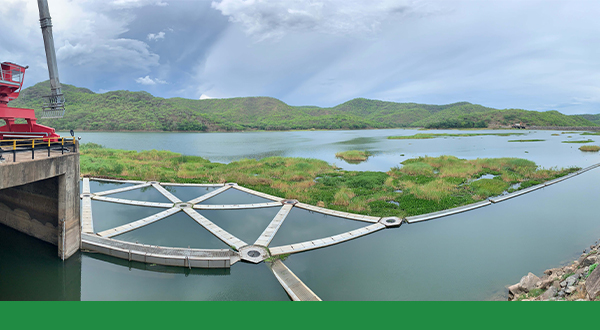
Infrastructure at the intakes of the Kafue River Gorge Upper Power Station, another dam in Zambia. The triangular booms keep floating plant mats from being sucked into the turbines and the crane is for removing debris.
With his new position at Stanford, Winton's focus has shifted to tropical peat wetlands in Latin America. But his work is likely to take him close to tropical dams facing the same challenges—and leaking carbon in similar ways—as what he helped define in Zambia. The biggest takeaway for Winton was the discoveries that can come from asking big questions of a multidisciplinary research team that brought water chemists, economists, social scientists, political scientists, and others together in the Zambezi Basin.
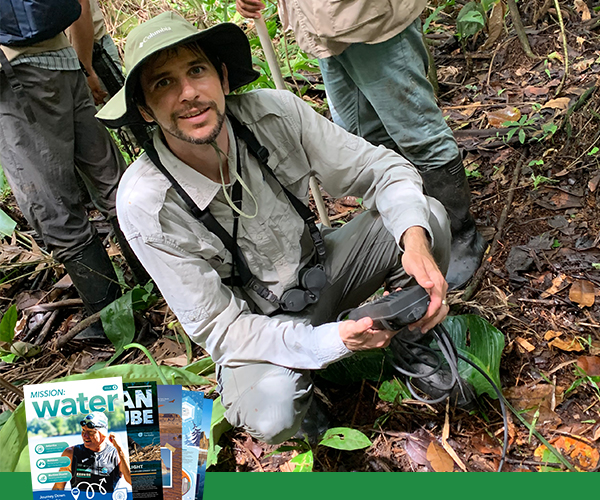
Dr. Winton's research in Zambia helped shine a light on the environmental impacts of hydroelectric dams.
"We basically went to Zambia with a broad question, which was 'what's the status of the water quality in this basin and what are the threats to it? How are dams going to affect it?'" Winton reflects.
The answer has huge implications for understanding what's happening deep in the reservoirs behind thousands of dams, and how decision-makers can better assess the impacts of hydroelectric power.
